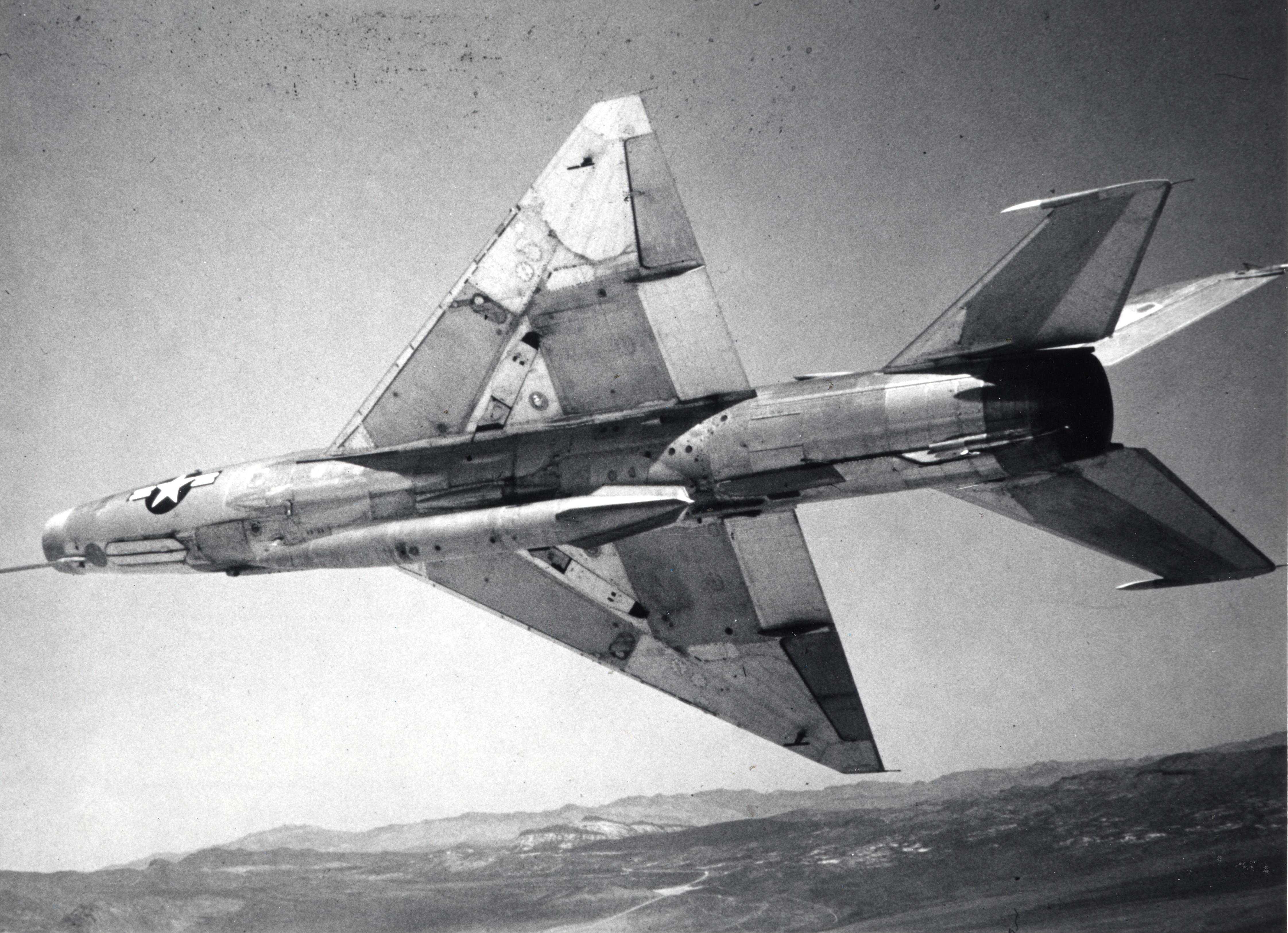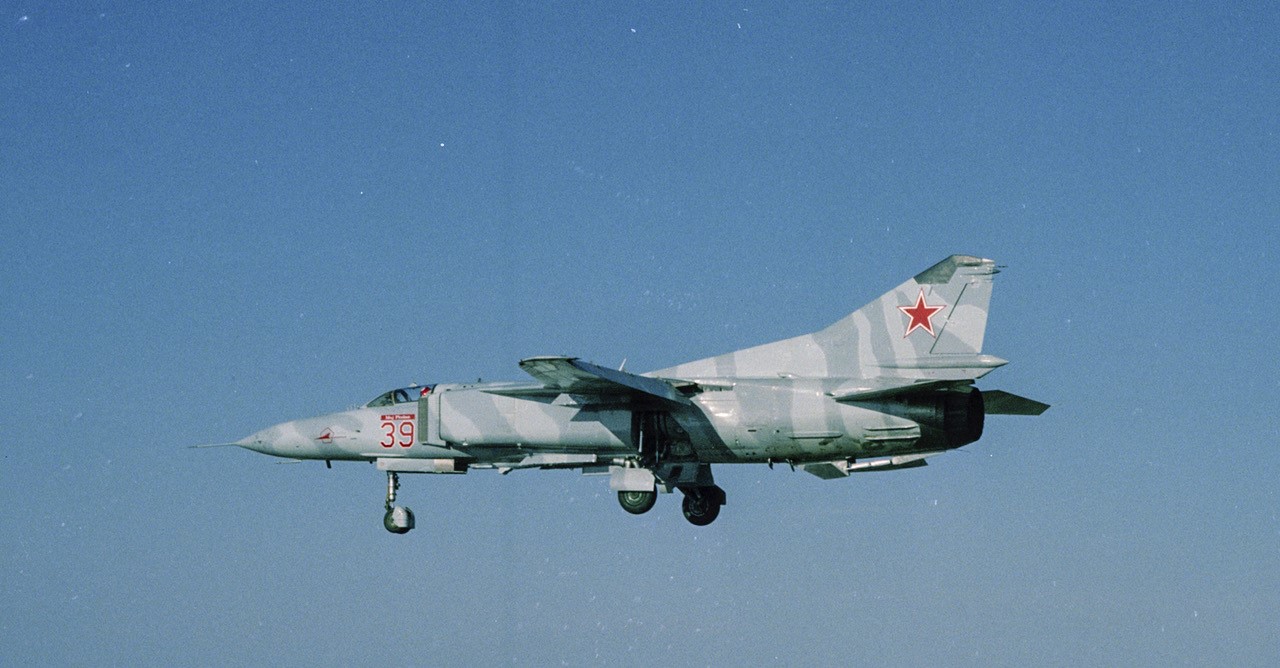Project Constant Peg was a secret program to train US Air Force, Navy, and Marine Corps fighter aircrews to fly against Soviet-designed aircraft. The USAF’s 4477th Test and Evaluation Squadron (TES), nicknamed the “Red Eagles,” flew MiG-17 “Fresco,” MiG-21 “Fishbed,” and later MiG-23 “Flogger” aircraft. The Red Eagles gave American aircrews the skills and confidence to defeat these threats in aerial combat.
Established in 1977, Constant Peg applied lessons learned earlier in Southeast Asia. Over North Vietnam, the USAF and USN had faced high losses to enemy aircraft, air-to-air missiles, and surface-to-air missiles. These losses sharply illustrated training shortfalls and a loss of skill in the art of the “dogfight.” Between 1972 and 1977, the USAF and USN started a number of specialized training programs to reinvigorate the fighter force, including establishing the first Aggressor squadrons. These squadrons flew USAF aircraft but employed Soviet tactics and flying techniques to simulate realistic adversaries. Constant Peg improved upon this method of instruction—Red Eagles pilots not only used Soviet fighter tactics but also flew the same MiG aircraft that their students could one day face in combat.
Constant Peg Beginnings
Establishing a secret squadron of Soviet aircraft from scratch was no simple task. The concept was pushed by a group of pilots from the Fighter Weapons School at Nellis AFB, Nevada. Their plan gained support at Tactical Air Command (TAC) headquarters and was championed at the Pentagon by Maj Gail Peck and a handful of senior leaders. Maj Gen Hoyt “Sandy” Vandenberg, Jr., Air Force Director of Operations and Readiness, gave the final go-ahead and lent his “call sign” Constant to the program. Maj Peck completed the name by adding Peg, his wife Peggy’s nickname.
A secret airfield was constructed on the Tonopah Test Range in remote Nevada.
This site concealed two classified programs–Constant Peg operated MiGs out of the airfield by day and at night the airfield was home to pilot training for the secret F-117 Nighthawk stealth fighter.
The Assets
In the late 1960s, the USAF secretly acquired and tested several MiGs in the classified Have Doughnut and Have Drill programs. These tests provided the first complete technical breakdowns of MiG-17 and MiG-21 aircraft. The USAF and other members of the intelligence community acquired additional MiGs, and USAF maintainers skillfully restored them for flight. The MiG-17 and MiG-21 formed the backbone of the Constant Peg fleet until they were joined by the MiG-23 in 1980. The Red Eagles retired the aging MiG-17s in 1982 due to obsolescence and safety concerns.
The Bandits: Red Eagle Pilots
Red Eagles pilots were selected primarily from the ranks of the Air Force Fighter Weapons School, Navy Fighter Weapons School (Topgun), and Aggressor squadrons. From 1977 to 1988, sixty-nine pilots flew with the squadron and each received their own unique “Bandit” number. Red Eagles pilots eagerly improved the level of instruction and scoured classified sources to improve their proficiency with the MiGs.
MiG Exposures
Due to the secrecy surrounding the Constant Peg program, the true nature of this specialized training was often kept from prospective students until the last minute. Many aircrew members were stunned when they spied their first Red Eagles MiG approaching during their initial flight training missions. A typical MiG exposure began with a radar intercept and a formation flight displaying the MiG’s performance profile. This flight was designed to eliminate “buck fever,” the pilot’s shock at seeing a MiG up-close for the first time. The second exposure demonstrated basic flight maneuvers and gave the student pilot practice in one-vs-one defensive and offensive maneuvers. These exercises illustrated MiG strengths and weaknesses in relation to the pilot’s own fighter aircraft. The final stage of training incorporated lessons in two-vs-two air combat maneuvers and simulated dogfights where Red Eagles pilots would employ Soviet tactics. After each phase of training, the pilots engaged in extensive debriefs to reinforce the most effective methods of attack. The USAF’s fleet of Soviet aircraft grew in reliability and numbers. The Red Eagles expanded their operations to include multi-aircraft vs multi-aircraft training sorties and participation in the USAF’s large-scale Red Flag combat exercises.
Maintaining the MiGs
Constant flying and unreliable Soviet equipment strained mission readiness. Replacement parts and expertise in Soviet aircraft maintenance were in short supply. Squadron aircraft typically arrived in poor condition and required lengthy periods of repair and reconditioning before they could fly. The Red Eagles’ team of experienced maintainers pioneered new techniques for keeping the small and irreplaceable fleet airborne. Red Eagles pilots and maintainers treated each aircraft as if it were a national treasure, but operating and maintaining the fragile MiGs was a dangerous endeavor. Three Red Eagles lost their lives in service—US Navy Lt Melvin “Hugh” Brown (Bandit 12) and USAF Capt Mark Postai (Bandit 25) were killed in aircraft accidents, and USAF TSgt Rey Hernandez was killed in an accident on the ground.
Constant Peg was terminated in 1988, and the 4477th TES was inactivated in 1990 in a funding drawdown at the end of the Cold War. In ten years, the Red Eagles flew more than 15,000 sorties and trained almost 6,000 US aircrew against Constant Peg MiGs. Many credit this training as a factor in the overwhelming success of American airpower in Operation Desert Storm in 1990-1991. During Desert Storm, USAF pilots destroyed 40 Iraqi fighter aircraft, including 12 MiG-21s and MiG-23s, without sustaining any losses from enemy aircraft.

A 4477th TES MiG-21 “Fishbed” over the Nevada desert. Red Eagles aircraft flew with US markings until 1983 when Soviet-style colors and markings were applied.

A Red Eagles MiG-23 in flight over the Tonopah Test Range. The Red Eagles acquired their first MiG-23 “Floggers,” similar to the aircraft on exhibit, in November 1980.
.jpg?ver=2018-11-06-082838-360)
Lt Col John Manclark, commanding officer of the 4477th TES, and members of the Red Eagles with one of the squadron’s MiG-21s, about 1986.
Related Fact Sheets:
MiG-17 "Fresco"
MiG-21 "Fishbed"
MiG-23 "Flogger"
Return to Gallery pages:
Southeast Asia War Gallery
Cold War Gallery